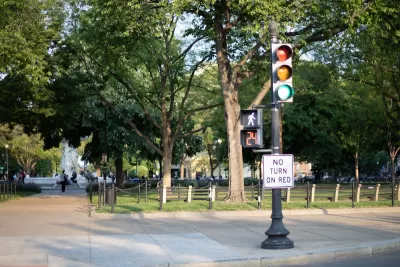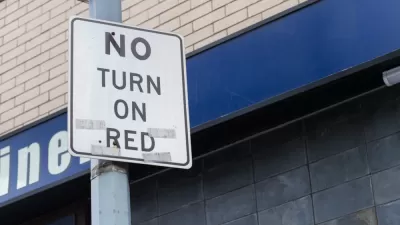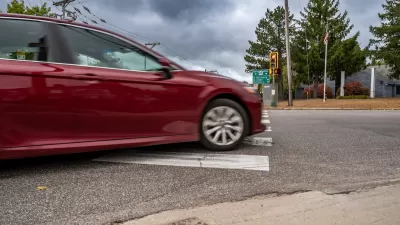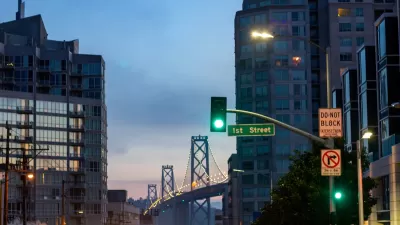The practice creates dangerous conditions for pedestrians, cyclists, and anyone crossing in front of turning vehicles.

A December report from the Mineta Transportation Institute offers new evidence that allowing drivers to turn right on red lights makes roads more dangerous for pedestrians and people on bikes, reports Dan Zukowski in Smart Cities Dive.
Zukowski explains, “The study noted that ‘most drivers do not come to a complete stop and instead roll through’ the red light, creating a safety hazard for pedestrians in the crosswalk.”
The practice dates back to the 1970s, when a federal law permitted the practice as a fuel-saving measure during that era’s gas crisis. Throughout the United States, most cities allow turning right on red except where otherwise noted. But intersections with right turns on red see higher rates of collisions, while “The MTI research, quoting an Insurance Institute for Highway Safety study, noted that the odds of pedestrians dying were 89% greater in a right-turn collision involving pickup trucks and 63% greater with SUVs.”
As electric vehicles, which are heavier and accelerate at a faster rate than combustion-engine cars, become more common, the study concludes that banning right turns on red could be a key element in reducing traffic deaths and injuries.
FULL STORY: Right turns on red puts pedestrians at risk, Mineta study says

Alabama: Trump Terminates Settlements for Black Communities Harmed By Raw Sewage
Trump deemed the landmark civil rights agreement “illegal DEI and environmental justice policy.”

Planetizen Federal Action Tracker
A weekly monitor of how Trump’s orders and actions are impacting planners and planning in America.

The 120 Year Old Tiny Home Villages That Sheltered San Francisco’s Earthquake Refugees
More than a century ago, San Francisco mobilized to house thousands of residents displaced by the 1906 earthquake. Could their strategy offer a model for the present?

LA’s Tree Emergency Goes Beyond Vandalism
After a vandal destroyed dozens of downtown LA trees, Mayor Karen Bass vowed to replace them. Days later, she slashed the city’s tree budget.

Sacramento Leads Nation With Bus-Mounted Bike Lane Enforcement Cameras
The city is the first to use its bus-mounted traffic enforcement system to cite drivers who park or drive in bike lanes.

Seattle Voters Approve Social Housing Referendum
Voters approved a corporate tax to fund the city’s housing authority despite an opposition campaign funded by Amazon and Microsoft.
Urban Design for Planners 1: Software Tools
This six-course series explores essential urban design concepts using open source software and equips planners with the tools they need to participate fully in the urban design process.
Planning for Universal Design
Learn the tools for implementing Universal Design in planning regulations.
Ada County Highway District
Clanton & Associates, Inc.
Jessamine County Fiscal Court
Institute for Housing and Urban Development Studies (IHS)
City of Grandview
Harvard GSD Executive Education
Toledo-Lucas County Plan Commissions
Salt Lake City
NYU Wagner Graduate School of Public Service





























